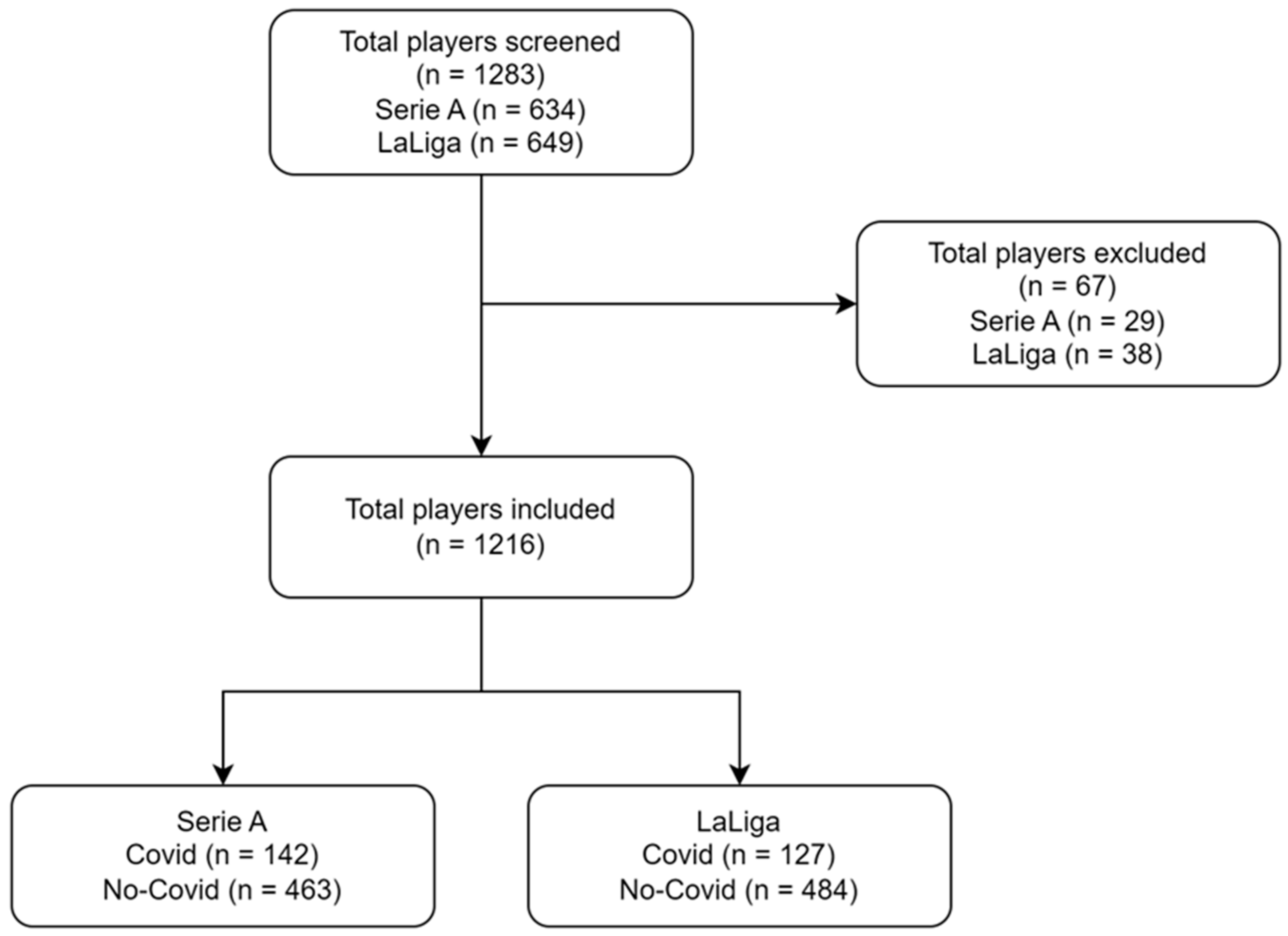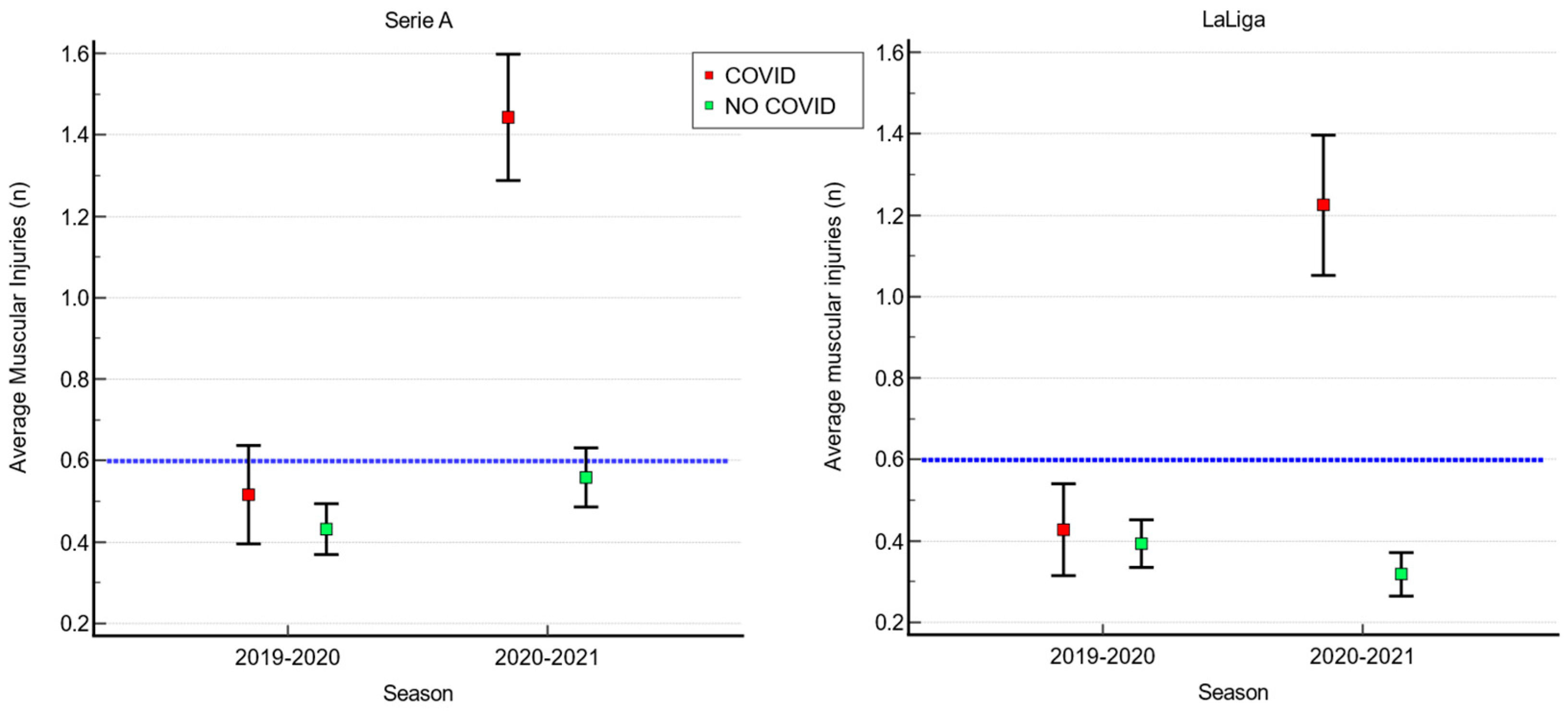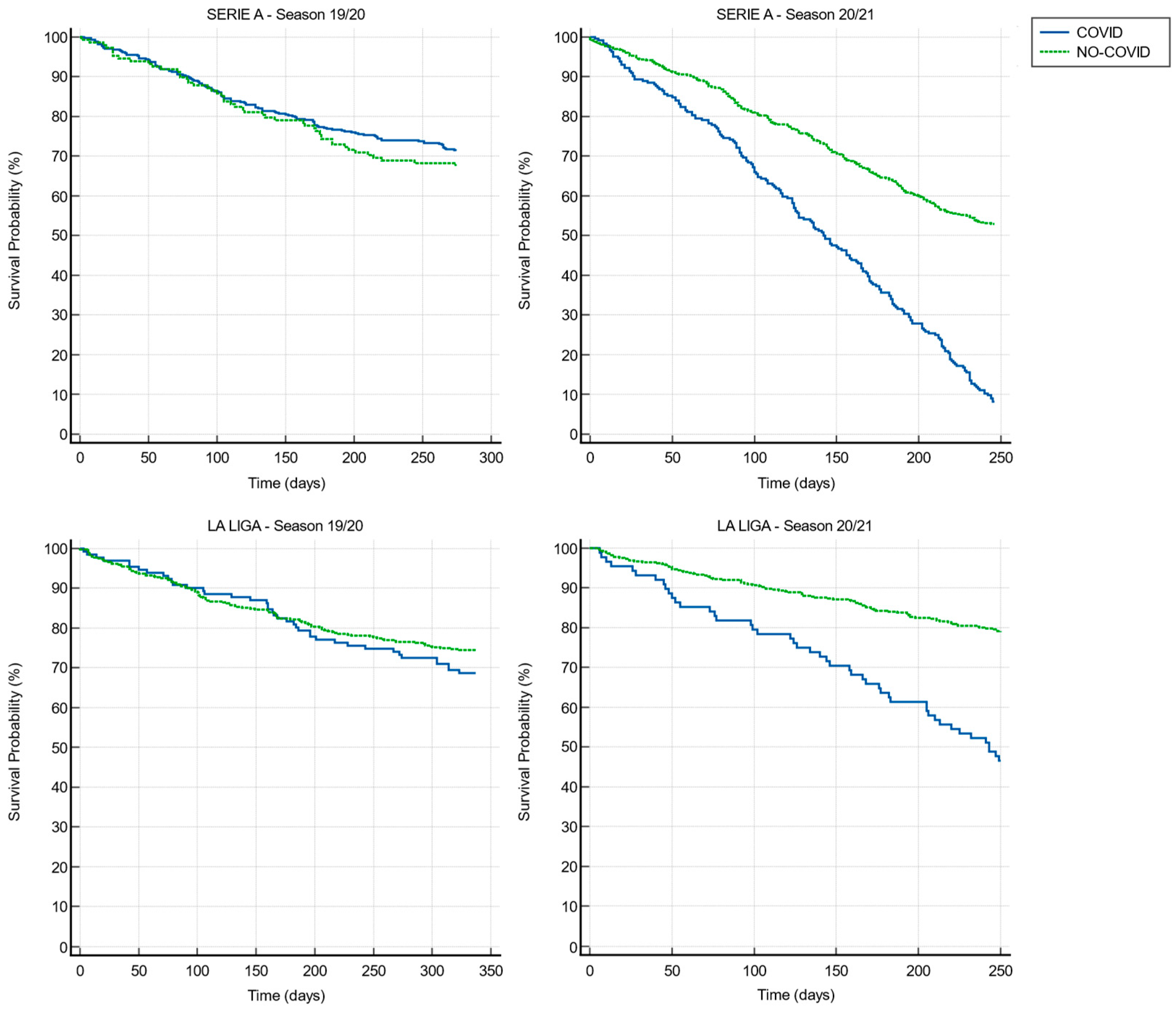SARS-CoV-2 Infection Increases the Risk of Muscle Injury in Professional Male Soccer Players—A Retrospective Analysis of the Italian and Spanish Major Leagues
Abstract
1. Introduction
2. Materials and Methods
2.1. Study Design
2.2. Data Collection
2.3. Statistical Analysis
3. Results
4. Discussion
4.1. Clinical Implications
4.2. Study Limitations
5. Conclusions
Author Contributions
Funding
Institutional Review Board Statement
Informed Consent Statement
Data Availability Statement
Conflicts of Interest
References
- Huang, C.; Wang, Y.; Li, X.; Ren, L.; Zhao, J.; Hu, Y.; Zhang, L.; Fan, G.; Xu, J.; Gu, X.; et al. Clinical Features of Patients Infected with 2019 Novel Coronavirus in Wuhan, China. Lancet 2020, 395, 497–506. [Google Scholar] [CrossRef]
- Cucinotta, D.; Vanelli, M. WHO Declares COVID-19 a Pandemic. Acta Bio Med. Atenei Parm. 2020, 91, 157. [Google Scholar] [CrossRef]
- Manzi, V.; Annino, G.; Savoia, C.; Caminiti, G.; Padua, E.; Masucci, M.; D’Onofrio, R.; Iellamo, F. Relationship between Aerobic Fitness and Metabolic Power Metrics in Elite Male Soccer Players. Biol. Sport 2021, 39, 599–606. [Google Scholar] [CrossRef] [PubMed]
- Krustrup, P.; Mohr, M.; Steensberg, A.; Bencke, J.; Klær, M.; Bangsbo, J. Muscle and Blood Metabolites during a Soccer Game: Implications for Sprint Performance. Med. Sci. Sports Exerc. 2006, 38, 1165–1174. [Google Scholar] [CrossRef] [PubMed]
- Ekstrand, J.; Waldén, M.; Hägglund, M. Hamstring Injuries Have Increased by 4% Annually in Men’s Professional Football, since 2001: A 13-Year Longitudinal Analysis of the UEFA Elite Club Injury Study. Br. J. Sports Med. 2016, 50, 731–737. [Google Scholar] [CrossRef]
- Ekstrand, J.; Bengtsson, H.; Waldén, M.; Davison, M.; Khan, K.M.; Hägglund, M. Hamstring Injury Rates Have Increased during Recent Seasons and Now Constitute 24% of All Injuries in Men’s Professional Football: The UEFA Elite Club Injury Study from 2001/02 to 2021/22. Br. J. Sports Med. 2023, 57, 292–298. [Google Scholar] [CrossRef] [PubMed]
- Serviente, C.; Decker, S.T.; Layec, G. Long-Term Recovery from SARS-CoV-2 (COVID-19): From Heart to Muscle: Pathophysiological Mechanisms Underlying Long-Term Physical Sequelae from SARS-CoV-2 Infection. J. Appl. Physiol. 2022, 132, 581. [Google Scholar] [CrossRef]
- Jia, L.; Carter, M.V.; Cusano, A.; Li, X.; Kelly, J.D.; Bartley, J.D.; Parisien, R.L. The Effect of the COVID-19 Pandemic on the Mental and Emotional Health of Athletes: A Systematic Review. Am. J. Sports Med. 2022. [Google Scholar] [CrossRef]
- Haan, R.; Ali Alblooshi, M.E.; Syed, D.H.; Dougman, K.K.; al Tunaiji, H.; Campos, L.A.; Baltatu, O.C. Health and Well-Being of Athletes during the Coronavirus Pandemic: A Scoping Review. Front. Public Health 2021, 9, 255. [Google Scholar] [CrossRef]
- Montes-Ibarra, M.; Oliveira, C.L.P.; Orsso, C.E.; Landi, F.; Marzetti, E.; Prado, C.M. The Impact of Long COVID-19 on Muscle Health. Clin. Geriatr. Med. 2022, 38, 545. [Google Scholar] [CrossRef]
- Seshadri, D.R.; Thom, M.L.; Harlow, E.R.; Drummond, C.K.; Voos, J.E. Case Report: Return to Sport Following the COVID-19 Lockdown and Its Impact on Injury Rates in the German Soccer League. Front. Sports Act. Living 2021, 3, 604226. [Google Scholar] [CrossRef]
- García-Calvo, T.; Fernandez-Navarro, J.; Díaz-García, J.; López-Del Campo, R.; Martínez Fernández, F.; Memmert, D. The Impact of COVID-19 Lockdown on Soccer Positional and Physical Demands in the Spanish La Liga. Sci. Med. Footb. 2023, 7, 124–130. [Google Scholar] [CrossRef]
- Mannino, B.J.; Yedikian, T.; Mojica, E.S.; Bi, A.; Alaia, M.; Gonzalez-Lomas, G. The COVID Lockdown and Its Effects on Soft Tissue Injuries in Premier League Athletes. Physician Sportsmed. 2023, 51, 40–44. [Google Scholar] [CrossRef]
- Marotta, N.; de Sire, A.; Gimigliano, A.; Demeco, A.; Moggio, L.; Vescio, A.; Iona, T.; Ammendolia, A. Impact of COVID-19 Lockdown on the Epidemiology of Soccer Muscle Injuries in Italian Serie Aprofessional Football Players. J. Sports Med. Phys. Fit. 2022, 62, 356–360. [Google Scholar] [CrossRef]
- Wezenbeek, E.; Denolf, S.; Willems, T.M.; Pieters, D.; Bourgois, J.G.; Philippaerts, R.M.; de Winne, B.; Wieme, M.; van Hecke, R.; Markey, L.; et al. Association between SARS-CoV-2 Infection and Muscle Strain Injury Occurrence in Elite Male Football Players: A Prospective Study of 29 Weeks Including Three Teams from the Belgian Professional Football League. Br. J. Sports Med. 2022, 56, 818–823. [Google Scholar] [CrossRef] [PubMed]
- Vandenbroucke, J.P.; von Elm, E.; Altman, D.G.; Gøtzsche, P.C.; Mulrow, C.D.; Pocock, S.J.; Poole, C.; Schlesselman, J.J.; Egger, M. Strengthening the Reporting of Observational Studies in Epidemiology (STROBE): Explanation and Elaboration. PLoS Med. 2007, 4, 1628–1654. [Google Scholar] [CrossRef] [PubMed]
- Annino, G.; Manzi, V.; Alashram, A.R.; Romagnoli, C.; Coniglio, M.; Lamouchideli, N.; Perrone, M.A.; Limongi, D.; Padua, E. COVID-19 as a Potential Cause of Muscle Injuries in Professional Italian Serie A Soccer Players: A Retrospective Observational Study. Int. J. Environ. Res. Public Health 2022, 19, 11117. [Google Scholar] [CrossRef] [PubMed]
- Wand, T. Analysis of the Football Transfer Market Network. J. Stat. Phys. 2022, 187, 27. [Google Scholar] [CrossRef] [PubMed]
- Grassi, A.; Macchiarola, L.; Filippini, M.; Lucidi, G.A.; della Villa, F.; Zaffagnini, S. Epidemiology of Anterior Cruciate Ligament Injury in Italian First Soccer Players. Sports Health 2020, 12, 279. [Google Scholar] [CrossRef] [PubMed]
- Schiffner, E.; Latz, D.; Grassmann, J.P.; Schek, A.; Scholz, A.; Windolf, J.; Jungbluth, P.; Schneppendahl, J. Fractures in German Elite Male Soccer Players. J. Sports Med. Phys. Fit. 2019, 110–115. [Google Scholar] [CrossRef]
- Mansournia, M.A.; Collins, G.S.; Nielsen, R.O.; Nazemipour, M.; Jewell, N.P.; Altman, D.G.; Campbell, M.J. A CHecklist for Statistical Assessment of Medical Papers (the CHAMP Statement): Explanation and Elaboration. Br. J. Sports Med. 2021, 55, 1009–1017. [Google Scholar] [CrossRef] [PubMed]
- Bengtsson, H.; Ekstrand, J.; Hägglund, M. Muscle Injury Rates in Professional Football Increase with Fixture Congestion: An 11-Year Follow-up of the UEFA Champions League Injury Study. Br. J. Sports Med. 2013, 47, 743–747. [Google Scholar] [CrossRef] [PubMed]
- Hägglund, M.; Waldén, M.; Magnusson, H.; Kristenson, K.; Bengtsson, H.; Ekstrand, J. Injuries Affect Team Performance Negatively in Professional Football: An 11-Year Follow-up of the UEFA Champions League Injury Study. Br. J. Sports Med. 2013, 47, 738–742. [Google Scholar] [CrossRef]
- Waldén, M.; Hägglund, M.; Ekstrand, J. UEFA Champions League Study: A Prospective Study of Injuries in Professional Football during the 2001–2002 Season. Br. J. Sports Med. 2005, 39, 542–546. [Google Scholar] [CrossRef]
- Green, B.; Bourne, M.N.; van Dyk, N.; Pizzari, T. Recalibrating the Risk of Hamstring Strain Injury (HSI): A 2020 Systematic Review and Meta-Analysis of Risk Factors for Index and Recurrent Hamstring Strain Injury in Sport. Br. J. Sports Med. 2020, 54, 1081–1088. [Google Scholar] [CrossRef] [PubMed]
- Green, B.; Pizzari, T. Calf Muscle Strain Injuries in Sport: A Systematic Review of Risk Factors for Injury. Br. J. Sports Med. 2017, 51, 1189–1194. [Google Scholar] [CrossRef] [PubMed]
- Pietsch, S.; Pizzari, T. Risk Factors for Quadriceps Muscle Strain Injuries in Sport: A Systematic Review. J. Orthop. Sports Phys. Ther. 2022, 52, 389–400. [Google Scholar] [CrossRef]
- Sarto, F.; Impellizzeri, F.M.; Spörri, J.; Porcelli, S.; Olmo, J.; Requena, B.; Suarez-Arrones, L.; Arundale, A.; Bilsborough, J.; Buchheit, M.; et al. Impact of Potential Physiological Changes due to COVID-19 Home Confinement on Athlete Health Protection in Elite Sports: A Call for Awareness in Sports Programming. Sports Med. 2020, 50, 1417–1419. [Google Scholar] [CrossRef] [PubMed]
- Heo, S.J.; Park, S.K.; Jee, Y.S. Detraining Effects of COVID-19 Pandemic on Physical Fitness, Cytokines, C-Reactive Protein and Immunocytes in Men of Various Age Groups. Int. J. Environ. Res. Public Health 2022, 19, 1845. [Google Scholar] [CrossRef]
- de Boer, M.D.; Maganaris, C.N.; Seynnes, O.R.; Rennie, M.J.; Narici, M.V. Time Course of Muscular, Neural and Tendinous Adaptations to 23 Day Unilateral Lower-Limb Suspension in Young Men. J. Physiol. 2007, 583, 1079–1091. [Google Scholar] [CrossRef]
- Lauersen, J.B.; Andersen, T.E.; Andersen, L.B. Strength Training as Superior, Dose-Dependent and Safe Prevention of Acute and Overuse Sports Injuries: A Systematic Review, Qualitative Analysis and Meta-Analysis. Br. J. Sports Med. 2018, 52, 1557–1563. [Google Scholar] [CrossRef]
- Miles, M.P.; Heil, D.P.; Larson, K.R.; Conant, S.B.; Schneider, S.M. Prior Resistance Training and Sex Influence Muscle Responses to Arm Suspension. Med. Sci. Sports Exerc. 2005, 37, 1983–1989. [Google Scholar] [CrossRef] [PubMed]
- Tan, L.Y.; Komarasamy, T.V.; RMT Balasubramaniam, V. Hyperinflammatory Immune Response and COVID-19: A Double Edged Sword. Front. Immunol. 2021, 12, 3981. [Google Scholar] [CrossRef]
- Hasan, L.K.; Deadwiler, B.; Haratian, A.; Bolia, I.K.; Weber, A.E.; Petrigliano, F.A. Effects of COVID-19 on the Musculoskeletal System: Clinician’s Guide. Orthop. Res. Rev. 2021, 13, 141. [Google Scholar] [CrossRef] [PubMed]
- Vasquez-Bonilla, A.A.; Brazo-Sayavera, J.; Timón, R.; Olcina, G. Monitoring Muscle Oxygen Asymmetry as a Strategy to Prevent Injuries in Footballers. Res. Q. Exerc. Sport 2022, 1–9. [Google Scholar] [CrossRef]
- Watson, A.; Brindle, J.; Brickson, S.; Allee, T.; Sanfilippo, J. Preseason Aerobic Capacity Is an Independent Predictor of In-Season Injury in Collegiate Soccer Players. Clin. J. Sport Med. 2017, 27, 302–307. [Google Scholar] [CrossRef] [PubMed]
- Elliott, N.; Martin, R.; Heron, N.; Elliott, J.; Grimstead, D.; Biswas, A. Infographic. Graduated Return to Play Guidance Following COVID-19 Infection. Br. J. Sports Med. 2020, 54, 1174–1175. [Google Scholar] [CrossRef]
- Martin, R.R.L.; Cibulka, M.T.; Bolgla, L.A.; Koc, T.A.; Loudon, J.K.; Manske, R.C.; Weiss, L.; Christoforetti, J.J.; Heiderscheit, B.C. Hamstring Strain Injury in Athletes. J. Orthop. Sports Phys. Ther. 2022, 52, CPG1–CPG44. [Google Scholar] [CrossRef]



| Data | Description |
|---|---|
| Birth date | |
| Age at the end of the 2020–2021 season | |
| Team | |
| Muscle injuries season 2019–2020 | Total number of muscular injury sustained by a player that resulted from a in-season football match or football training |
| Muscle injuries season 2020–2021 | |
| Matches played in the 2019–2020 | Total number of matches played during the season |
| Matches played in the 2020–2021 | |
| Minutes played season 2019–2020 | Total number of minutes played during the season |
| Minutes played season 2020–2021 | |
| Date of SARS-CoV-2 infection | Date of in-season SARS-CoV-2 infection |
| Date of muscle injuries season 2019–2020 | Date of each muscle injury occurred during in-season period |
| Date of muscle injuries season 2020–2021 | |
| Season 2019–2020 start and end date | First and last match date of the season |
| Season 2020–2021 start and end date |
| Independent Variables | Coefficient | Std. Error | t | p | R2 | Analysis of Variance | |
|---|---|---|---|---|---|---|---|
| F-Ratio | p | ||||||
| 2019/2020 season | 0.041 | 7.5649 | <0.05 | ||||
| (Constant) | −0.123 | ||||||
| Age | 0.023 | 0.006 | 3.900 | <0.05 | |||
| Minutes played | −0.000 | 0.000 | −3.679 | <0.05 | |||
| Matches played | 0.025 | 0.007 | 3.613 | <0.05 | |||
| Group (C+/C−) | −0.108 | 0.065 | −1.658 | 0.098 | |||
| 2020/2021 season | 0.185 | 34.242 | <0.05 | ||||
| (Constant) | 1.770 | ||||||
| Age | 0.020 | 0.007 | 2.814 | 0.005 | |||
| Minutes played | −0.000 | 0.000 | −1.269 | 0.205 | |||
| Matches played | 0.006 | 0.007 | 0.910 | 0.363 | |||
| Group (C+/C−) | −0.889 | 0.078 | −11.371 | <0.05 | |||
| Independent Variables | Coefficient | Std. Error | t | p | R2 | Analysis of Variance | |
|---|---|---|---|---|---|---|---|
| F-Ratio | p | ||||||
| 2019/2020 season | 0.007 | 1.113 | 0.349 | ||||
| (Constant) | 0.110 | ||||||
| Age | 0.0129 | 0.006411 | 2.022 | 0.044 | |||
| Minutes played | −0.000 | 0.00006924 | −0.426 | 0.670 | |||
| Matches played | 0.002 | 0.006129 | 0.337 | 0.736 | |||
| Group (C+/C−) | −0.042 | 0.06376 | −0.663 | 0.508 | |||
| 2020/2021 season | 0.217 | 42.258 | <0.05 | ||||
| (Constant) | 2.141 | ||||||
| Age | 0.000 | 0.007 | 0.087 | 0.931 | |||
| Minutes played | 0.000 | 0.000 | 0.697 | 0.486 | |||
| Matches played | −0.004 | 0.006 | −0.749 | 0.454 | |||
| Group (C+/C−) | −0.902 | 0.069 | −12.916 | <0.05 | |||
Disclaimer/Publisher’s Note: The statements, opinions and data contained in all publications are solely those of the individual author(s) and contributor(s) and not of MDPI and/or the editor(s). MDPI and/or the editor(s) disclaim responsibility for any injury to people or property resulting from any ideas, methods, instructions or products referred to in the content. |
© 2023 by the authors. Licensee MDPI, Basel, Switzerland. This article is an open access article distributed under the terms and conditions of the Creative Commons Attribution (CC BY) license (https://creativecommons.org/licenses/by/4.0/).
Share and Cite
Miccinilli, S.; Bravi, M.; Conti, G.; Bressi, F.; Sterzi, S.; Santacaterina, F.; Ciccozzi, M. SARS-CoV-2 Infection Increases the Risk of Muscle Injury in Professional Male Soccer Players—A Retrospective Analysis of the Italian and Spanish Major Leagues. Infect. Dis. Rep. 2023, 15, 425-435. https://doi.org/10.3390/idr15040043
Miccinilli S, Bravi M, Conti G, Bressi F, Sterzi S, Santacaterina F, Ciccozzi M. SARS-CoV-2 Infection Increases the Risk of Muscle Injury in Professional Male Soccer Players—A Retrospective Analysis of the Italian and Spanish Major Leagues. Infectious Disease Reports. 2023; 15(4):425-435. https://doi.org/10.3390/idr15040043
Chicago/Turabian StyleMiccinilli, Sandra, Marco Bravi, Giorgio Conti, Federica Bressi, Silvia Sterzi, Fabio Santacaterina, and Massimo Ciccozzi. 2023. "SARS-CoV-2 Infection Increases the Risk of Muscle Injury in Professional Male Soccer Players—A Retrospective Analysis of the Italian and Spanish Major Leagues" Infectious Disease Reports 15, no. 4: 425-435. https://doi.org/10.3390/idr15040043
APA StyleMiccinilli, S., Bravi, M., Conti, G., Bressi, F., Sterzi, S., Santacaterina, F., & Ciccozzi, M. (2023). SARS-CoV-2 Infection Increases the Risk of Muscle Injury in Professional Male Soccer Players—A Retrospective Analysis of the Italian and Spanish Major Leagues. Infectious Disease Reports, 15(4), 425-435. https://doi.org/10.3390/idr15040043








